Wilder’s Master Guide, Lu Warner, gives his monthly Taylor River fishing report. Be sure to tap into his expertise to ensure a successful day of fly-fishing on the Taylor.
As we roll through September, fishing conditions at the Wilder could not be better. Beautiful Fall days, consistent hatches and perfect water levels, make this one of the best times of year to spend some quality hours on the water. Current release levels at the dam are 300 CFS and as of today, we have about 410 CFS flowing through Wilder. This is a good level to fish the river as there is still enough water to provide a plentiful habitat, yet wading is less sporty and most of the river is accessible.
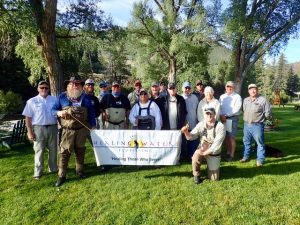 We just finished sponsoring Project Healing Waters at the Ranch for four days. This is a special event for us at Wilder and we were proud to have the soldiers experience some great fishing, food and accommodations. Special thanks to Don and Shelly who hosted the trip and Seth, Jim, Mike Zach, CJ and David from Dragonfly Anglers. Everyone had a great time and some beautiful fish were caught and released.
We just finished sponsoring Project Healing Waters at the Ranch for four days. This is a special event for us at Wilder and we were proud to have the soldiers experience some great fishing, food and accommodations. Special thanks to Don and Shelly who hosted the trip and Seth, Jim, Mike Zach, CJ and David from Dragonfly Anglers. Everyone had a great time and some beautiful fish were caught and released.
Strong signs of Fall are apparent lately. Leaves are starting to turn, brown trout are becoming more colorful and ready to spawn. Mornings are frosty and hundreds of Kokanee Salmon have come in. About a week ago, we witnessed pod after pod of salmon blazing through Wilder on their way upriver, yet many stayed and the deep holes are now quite full. We have a plague of salmon! Although they are strong and fun to catch, they are not fun to fish for. A unique technique involving repetitive casting with a heavy fly, split shots and a bobber are required when fishing into the large schools of fish held in the deep holes. They are not feeding, so they react only out of aggression. If you keep dragging your fly, one will eventually swat at your fly with his mouth and you may hook him.
As the salmon come into the deep holes and occupy them, trout are often pushed out and this can be a positive effect for the fly fishermen as big fish can move into shallow water where they are easier to spot and catch. As the salmon spawn season goes on into October, trout will gather below the salmon redds to eat the eggs and again, although not the funniest type of fishing, egg patterns will become very effective and some large trout can be sight fished and caught if conditions are right.
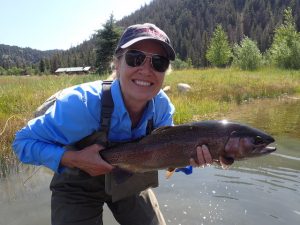 Right now on the Taylor river, it is all about clouds. We can have some amazing hatches if we get clouds between 12:30 and 2:30 pm. During this time you can see Gray Drakes, BWO’S and PMD’s hatching. Sunnier afternoons never produce as well, although you will still catch fish on a well presented dry even if they aren’t rising.
Right now on the Taylor river, it is all about clouds. We can have some amazing hatches if we get clouds between 12:30 and 2:30 pm. During this time you can see Gray Drakes, BWO’S and PMD’s hatching. Sunnier afternoons never produce as well, although you will still catch fish on a well presented dry even if they aren’t rising.
Mornings fishing is good on the river as well. Clouds of Tricos blanket the water around 10 am each day, but the few risers that can be found seem to prefer the larger PMD and Drake Spinners from the day before. I’ve been favoring a #14 Rusty Para Spinner in the mornings while fishing in calmer waters on 6x tippet. This time of year, the fish are a bit shy, so using 6x tippets and leaders around 12 feet in length will greatly increase your success rate. The truth is that most fish will not rise in the mornings and we’ve had success with a variety of droppers including Zebra Midges, Hare’s Ears, Pheasant tails, Psycho Mays and BWO nymphs and emerges such as RS-2’s. Fishing underneath a #12 Para Adams has proved deadly especially with a 4 foot 6x dropper line for better and deeper drifts.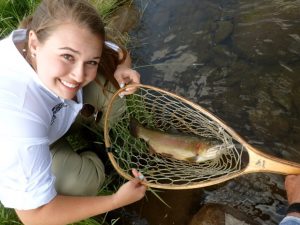
As we approach lunch time, the fish seem to be looking for an excuse to rise and many different dry fly patterns have been fishing well, such as Para Adams, PMD’s, BWO, Hoppers and large Stimulators (which imitates the Fall caddis that are starting to appear). Concentrate on soft presentations and perfect drifts and you will be successful. The number one thing that I see day after day on the water, is that the harder your dry fly hits the water, the less of a chance you have of catching a fish on that drift. On the Taylor river, fish will eat a number of different bugs if they are presented correctly.
If clouds appear between 1 and 2:20 pm you may be in for a treat, as clouds of Mayflies will hatch under these conditions and fish will rise like crazy. Gray Drakes, PMD’s and BWO’s are the big hatches right now and although the fish will eat all of them, the BWO seems to be the tastiest and fish seem to prefer them over all of the others. When in doubt, fish a #20 BWO or Para Adams and you will catch a fish. Regardless of cloud conditions, by around 3:30 the river seems to shut down and the fish are much less aggressive. This is a good time to concentrate on deep nymphing the big holes and fast water edges.
As the Browns get ready to spawn they get pretty aggressive and Streamer fishing can be a good way to catch a big one. I prefer early mornings, late evenings or solid overcast days to swing heavy flies through the runs and try to trigger a big strike. Proper mending is important to get your fly down and control the swing as you bring it in front of the fish. Vary your retrieves from a slow swing to a fast rip and try to find a pattern. Sculpzillas, Sex Dungeons, Dalai Lamas in Black, Olive, Olive and White are a good place to start. Adjust your tippet size to match and for large Streamers, use a minimum of 2x as tight lines strikes and be vicious.
Over the next few weeks as the season winds down, river levels will continue to drop, BWO hatches will get stronger and we should have some of the best dry fly fishing of the season right up until it’s to cold to be outside. Take advantage of this fantastic time of year and head to the river. You won’t be sorry.
The Dream Stream presents a good challenge right now to anyone that fishes it. The fish are easily spooked and pretty difficult to catch. Difficult, but not impossible. Sneaky and stealth like presentation, long leaders, and patience can produce good results.
In the mornings fish can be found rising for some very interesting micro bugs that I believe to be tiny leaf hoppers. These #28 yellow bugs will blanket the water between 9-11 am and the fish get very selective. Unable to match this hatch, I have had limited success with #22 Para Adams and BWO’s. Best bet is to combine a long leader, very small dry, and a long well placed cast. Cast once or twice to a fish and if he doesn’t eat, try another fly. Be patient. One of the difficulties here is that there are some monster fish and a lot of sharp rocks, so using 6x tippet is not a good option. Using 4x tippet on a #22 fly seems a bit ridiculous, but I always like to start there and see if it works. Cut it at a sharp angle in order to make threading your fly easier. Your odds of landing an 8lb rainbow with 4x are much higher than with 5x.
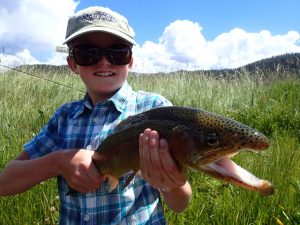 As we approach lunch time, some BWO’s will start to hatch and fish will start to eat. I like a #20 BWO thorax pattern and walk slowly along the stream looking for rising fish. Once you see a fish rising, take some time to figure out your approach. I like to get into casting position and wait to see the fish rise again before casting. This takes patience but the rewards can be high. At some point during the day, usually after lunch and particularly on a windy afternoon, the fish will be looking for Hoppers. We’ve had luck with a variety of different Hopper patterns including Madame X’s, Para Hoppers, Dave’s Hoppers and Super Chernobyls. I recommend fishing these larger patterns on a 9 foot 3x leader to get proper turnover and to prevent spinning the tippet.
As we approach lunch time, some BWO’s will start to hatch and fish will start to eat. I like a #20 BWO thorax pattern and walk slowly along the stream looking for rising fish. Once you see a fish rising, take some time to figure out your approach. I like to get into casting position and wait to see the fish rise again before casting. This takes patience but the rewards can be high. At some point during the day, usually after lunch and particularly on a windy afternoon, the fish will be looking for Hoppers. We’ve had luck with a variety of different Hopper patterns including Madame X’s, Para Hoppers, Dave’s Hoppers and Super Chernobyls. I recommend fishing these larger patterns on a 9 foot 3x leader to get proper turnover and to prevent spinning the tippet.
When a large fish comes up to eat your Hopper, make sure to pause a little longer before setting the hook. Quick hook sets are necessary when fishing a dropper as the fish already has the fly in it’s mouth when your dry moves. They also work fine for small dries, size 14 and under should enter the fishes mouth quickly. With big dries, especially big foam dries which have a lot of flotation, make sure that the fish is heading back down or closes his mouth before setting. It is very easy to see a big fish come slowly and pull the fly out of this mouth just before he closes it.
If the fish are not reacting to your dries, then by all means, try a dropper. On the Stream your dropper should be about 2 feet. Don’t make it to long or you will hang up on the bottom and shallow weed beds. Pheasant Tails in size 16-20 have worked very well and we’ve also caught fish on San Juan Worms, Hare’s Ears, Midges and Psycho Mays.
As you fish your way along the stream, keep in mind that you may want to cross back and forth to get a better angle on the next pool. Some drifts fish better from one side and by fishing all the holes from the correct side, you can maximize your time spent on the water. Last week, a client caught our first “grand slam” of the season with a Brook, Brown, Rainbow and Cutthroat from the Dream Stream. A good day on the water.
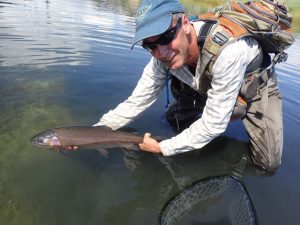 The ponds at Wilder have some giant rainbows and we caught a few last week. Ironically, a small Para Adams proved to be the most effective fly although fish have been caught on Hoppers, Beetles, Ants, Wooly Buggers and a variety of droppers. The fish are wary and as always a good presentation is key. I like to walk the banks and sight fish to a cruiser. I start by casting my fly maybe 15-20 feet in front of him and bringing closer on successive casts until he reacts. Try a few fish before changing your pattern and even try the same fish a few times until you are sure that he wants nothing to do with your fly. I have found that after repeated casting, the ponds cool off. So if you hook one or two or are casting in one area for longer than 10 minutes, start moving and look for some other fish or visit another pond. When the fish get spooked, it seems that they all sense it and it is important to recognize when to walk away.
The ponds at Wilder have some giant rainbows and we caught a few last week. Ironically, a small Para Adams proved to be the most effective fly although fish have been caught on Hoppers, Beetles, Ants, Wooly Buggers and a variety of droppers. The fish are wary and as always a good presentation is key. I like to walk the banks and sight fish to a cruiser. I start by casting my fly maybe 15-20 feet in front of him and bringing closer on successive casts until he reacts. Try a few fish before changing your pattern and even try the same fish a few times until you are sure that he wants nothing to do with your fly. I have found that after repeated casting, the ponds cool off. So if you hook one or two or are casting in one area for longer than 10 minutes, start moving and look for some other fish or visit another pond. When the fish get spooked, it seems that they all sense it and it is important to recognize when to walk away.
That being said, your best opportunity is your first cast so take your time, pay attention and make the first cast count. Each successive cast after that, your odds will go down. Be stealth and look for a big fish. There are some fish around 10lbs in the ponds that can be caught with the right technique.
All in all, it has been a wonderful season of fly fishing at Wilder and I look forward to the next month. Water conditions were high but good. The fish are plentiful, healthy, and strong hatches have brought fish to the surface consistently. With limited time before the cold weather sets in, I recommend making it a priority to get out on the water and catch some of the last Fall hatches and colorful Browns.
Learn more at https://wildercolorado.com/.









